News of Oil Platform PXXI
Oil Platform Turns Turtle for the last time.......updated 26th February 2007 .... Released in mid-Atlantic on 30th April 2006, lost on 16th May, sighted briefly on 23rd May, and found by Tristan Islanders on 7th June - the largest vessel ever to have foundered in Tristan waters has finally turned turtle for the last time 289 days after being cast adrift (and at least 250 days after being wrecked at Trypo) in February 2007. Choose whether to read the entire saga from the top....or Click to go to latest news direct from the South Atlantic. |
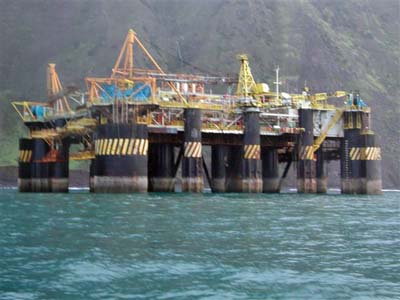 |
Oil Production Platform A Turtle
aground on the reef off Trypot Bay SE Coast of Tristan da Cunha June 2006 with 21st Century communications - how can a huge (104 x 103 metre x13 metre draft x 6357 tonnes)oil platform get lost in the South Atlantic Ocean and threaten one of the world's most precious environments? |
| Missing Oil Platform : Released 30th April ...... and lost Message Received from Tristan Radio Operator Andrea Repetto and updated 10th June 2006 The Tug Mighty Deliverer Departed from Macae in Brazil on 6th March 2006 en route via Cape Town to Singapore towing a semi submersible oil platform PXXI.; Due to bad weather it was forced to release the oil platform on 30th April 2006. Position 35.48s and 013.35w in order to avoid risk to the tug and towage. Eye Contact was maintained until 10th May, but, during bad weather the platform PXXI began to draw away and was lost on 16th May. Later sight of the unmanned, bunker and contamination free platform was re-gained at 11.00utc on 23rd May, position 35.56s and 013.58w approx 98 miles NW of Tristan. A second contact was made at 15.30utc position 37.14s and 013.26w approx 55 miles West of Tristan and approx 36 miles west of Inaccessible. Sight of the platform was again lost. Another Tug Ruby Deliverer joined in searching for the platform, with no success. |
|
| Oil Platform found at Tripot on 7th June Containing report from Chief Islander Anne Green Thursday 8th June 2006 Islanders have found the missing Oil Platform PXXI on washed ashore on the South-East coast at Trypot (see map page). The platform measures 104 metres x 103 metres with a draft of 13 metres and is 6357 gross tonnes in weight. Islanders were engaged in a winter trip to Sandy Point for beef cattle on Wednesday 7th June, and, whilst the boat was off shore fishing the sighted the platform on one of Tristan da Cunha's most inaccessible stretches of coastline. Sheer cliffs rise some 500 metres from a narrow boulder beach which from late August is occupied by a breeding colony of Northern Rockhopper Penguins. A search party in the two Police RIBs set out today (8/6/2006) to investigate the wreck and report to the owners. There have been several storms and high seas in the South Atlantic since the platform was last seen west of Tristan on 23rd May. |
|
Oil Platform Investigated on 8th June |
|
| Oil Platform Identity and Salvage Operation Confirmed - Monday 12th June Containing reports from the UK Foreign and Commonwealth Office and Administrator Mike Hentley in the UK Firstly, it seems that PXXI has 'turned turtle' in more ways than one. Firstly the full original name of the platform (used in all official correspondence until today) was Petrobas XXI. However, whether it being the result of its capsize on Tristan da Cunha or not, the owners Catleia Oil Company, based in the Cayman Islands confirm that it is in fact called 'A Turtle'. Secondly, we learn that the company Charles Taylor Consulting have been employed by the owners and are in negotiation with a salvage company with a view to the recovery of the platform. They envisage sending a powerful tug from South Africa with equipment for diving and for carrying out any incidental repairs that are necessary to the platform. The team on board the tug would assess the situation and, all being well, would tow the platform off and take it to Cape Town. They now understand that the platform may be beached on the sloping seabed rather than aground on a reef and this may make the task of removing it easier. It will take the salvage team between five and six days to reach Tristan after mobilisation at Cape Town so it does not appear that anything is likely to happen very quickly.In the meantime mid-winter approaches in the South Atlantic. |
|
| Salvage Team on its way from Cape Town - Friday 16th June A salvage team from SMIT Salvage, under the leadership of Salvage Master Captain Ian Carrasco, left Cape Town on Friday 16th June destined for Tristan da Cunha with the aim of solving the challenging problem of the grounded PXX1. A reassuring message received from the company is optimistic in its style : ' We can assure you that our team is comprised of experienced professionals who are motivated by the prospect of a challenge and look forward to working and communicating with locals in an open and transparent manner. Please be aware that we run all of our operations with due care for personnel safety, operational safety, environmental protection and live and work by the slogan ' "Do it right- first time".' |
|
| Salvage Team's Rough Journey West - Tuesday 20th June The salvage team aboard tug ST 'Zouros Hellas' captained by Salvage Master Ian Carrasco have reported a delayed passage to Tristan da Cunha due to high seas. The crew have been suffering sea-sickness and the estimated arrival time at the Edinburgh anchorage is now 18.00 GMT on Thursday 22nd June. The team will have room for two Islanders with local knowledge of the Trypot Bay site of the stricken oil platform 'A Turtle', and will proceed to this site as soon as formalities are cleared with the Tristan Government Administration. |
|
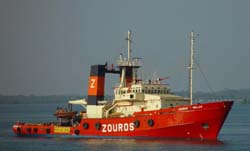 |
Salvage Tug ST Zouros Hellas The tug is 1487 gross tonnes & 66.7 metres long. Its two engines can produce 10,000 BHP and it has a maximum speed of 15 knots, and a service speed of 11 knots. It has accommodation for 27 officers and crew. The tug carries several towing wires up to 1800 metres long and with a gauge of 26 or 32 mm. The team hope to send photographs to tristandc.com, but are hoping for weather like that when this photograph was taken, but rarely seen around Tristan! |
| Rescue Mission Underway ST Zouros Hellas arrived at 16.30 GMT on Thursday 22nd June at the Tristan anchorage, passing MV Edinburgh en route to Cape Town. The salvage team came ashore for a planning meeting. It was decided to travel to Trypot Bay to reconnoiter the site, including looking at anchorage positions taking depth soundings. They plan to take the tug in close enough to the rig to attach lines to it and then work from there. A team of Islanders was headed by Police Inspector Conrad Glass, and Natural Resources Officer James Glass, accompanied by Mark Swain, John Lavarello and Martin Green. John and Martin are fishermen with local knowledge of the Trypot reef gained from setting crawfish pots over the years. The party departed in the small police RIB, with James Glass travelling on the tug. All the Islanders returned in the RIB. |
|
| Rig Inspection Complete - calculations to re-float underway Poor weather between Saturday 24th June and Monday 26th June prevented Islanders joining the rescue team aboard the tug Zouros Hellas. Radio reports indicated that the team have completed their rig inspection and were calculating whether the rig could be successfully re-floated. On Tuesday 27th a RIB has set off from Calshot Harbour crewed by Neil Swain, Jack Green, Martin Green and John Lavarello. |
|
| Report from Salvage Master Ian Carrasco received Tuesday 27th June The rig has been inspected and it is believed that it can be floated off. The salvage team have been getting systems (compressor and emergency generator) running on board the rig. The Naval Architect is doing the necessary calculations to see what can be done to float the rig. It was discovered that one of the columns on the starboard side was flooded. Three columns on the starboard side aft are permanently aground, all other pontoons [17] have floatation. Soundings have been taken to the seaward of the rig in preparation for removal. |
|
| Thursday 29th June - 1st Flotation Attempt Fails - report from the salvors The weather improved and at 08.40 the tug positioned herself close to the rig. The rubber boat was launched at 09.10 to pick up the floating line on the towing pennant of the rig and hand it to the tug. The tug anchored at 09.15 and preparations were made in the morning until using various power settings either side of high water at 15.00 in an effort to re-float A-Turtle. Although there was a lot of shaking in the rig, she did not move one cm. During the towing, the salvage team worked on the rig to replenish some fuel for the navigation lights generator and the emergency set. The re-floating effort was stopped at 17.00 and the tug retrieved her anchor at 17.30 as the wind and sea had increased again. Following the failure of Salvage Tug ST Zouros Hellas to free the stricken rig, a decision has been made to mobilise a second tug to help free A Turtle from the Trypot reef. |
|
| Saturday 1st July An attempt was made to get aboard the rig A Turtle but the swell was too big to gain safe access. |
|
| Sunday 2nd July The salvage team expected to carry out a dive inspection on the starboard side pontoon but dive conditions (swell and visibility) were not suitable. Also found that two ballast tank on the starboard side are flooded having been penetrated from the outside. They are preparing to place pumps on board to see if they can reduce the quantity of ballast water on board through pumping or air pressurisation. This will take a few days to set up in preparation for when the second tug arrives. |
|
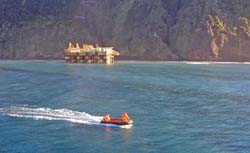 |
Islanders travelled by RIB to Trypot Bay on Sunday 2nd July Members of the salvage team aboard their Zodiac returning from an unsuccessful attempt to dive (see above) with A Turtle dwarfed by Trypot cliffs. Photo. taken aboard ST Zouros Hellas. |
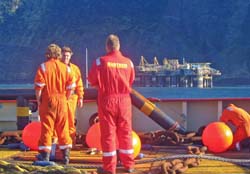 |
Salvage team members aboard ST Zouros Hellas working out their next move to try to free A Turtle from what is hoped will be its temporary home. |
| Monday 3rd July - News from Salvage Master Ian Carrasco Conditions at the Rig in Tripod Bay were again suitable for gaining access today. The salvage team is at present fabricating flanges for air connections for pressurizing the tanks that are tidal. [Open to the sea] In addition electric pumps and hoses have been positioned in the starboard pump room in an attempt to lower the level of water, and create more buoyancy when it comes time to re-float the rig. Approximately 100 tons of water was pumped out of the starboard centre column in 2.5 hours today. Soundings taken today indicate that the port [seaward side of rig] ballast tanks are intact.[not open to the sea] Status of the rig remains unchanged since the previous inspection, although the rig is still being subjected to heavy bottom contact on the port side, with resultant shuddering. |
|
| Tuesday 4th July - News from Salvage Master Ian Carrasco The salvage team did not manage to gain access to the Rig this morning due to the prevailing onshore winds and unsettled sea conditions. The second tug, Fairmont Sherpa, is now scheduled to leave Cape Town during the morning of Wednesday 5th July, ETA Tristan Monday 10th or Tuesday 11th July. The tug has a capacity of some 200 tons bollard pull. It is now calculated, that, in tandem with ST Zouros Hellas, it should provide enough power to re-float the Rig. |
|
| Friday 7th July - Edited news bulletin from Salvage Master Ian Carrasco Very strong north-west winds and rough seas have prevented access to the rig this morning and the forecast is poor for the weekend ahead. Plans for the dispatch of a second tug from Cape town have been changed and delayed. It is understood that the tug 'Sea Tiger' is due to depart on Saturday 8th July, ETA Tristan da Cunha Thursday 13th or Friday 14th July. |
|
Monday 10th July - Edited news bulletin from Salvage Master Ian Carrasco |
|
| Tuesday 11th July - Edited news bulletin from Salvage Master Ian Carrasco The salvage team was not able to board the Rig again this morning due to a large SW swell and unsettled sea conditions, which makes it unsafe for them to board by R.I.B. Yesterday afternoon the Tug “Sea Tiger” was ready to leave Cape Town for Tristan when she encountered technical problems in the engine room, and was not able to depart. We are awaiting confirmation as to the extent of the damage and time frame necessary for her to complete the repairs. In the meantime the Owners/Underwriters of the Rig “A Turtle” are looking at other alternatives. At present we are anchored off the Settlement seeking shelter from the South Westerly swell. |
|
Wednesday 12th July - |
|
| Thursday 13th July Latest Edited News from Salvage Master Ian Carrasc0 The salvage team managed to board the Rig today to carry out an inspection, and continue with efforts in preparation for the second pull attempt. During the inspection a further ballast tank on the inboard starboard pontoon was found to be tidal, 2 m of water was found in the pump-room on inner starboard side, and efforts to pump water from flooded columns and ballast tanks continue. No further news of a 2nd tug being booked to assist. During dives it was confirmed that the rig remained in its original position when it went aground on the Trypot reef, and this contradicts a report, received on 12th July and based on GPS, that the rig had moved 27 metres towards the shore. That report has now been erased. |
|
| Saturday 15th July Latest Edited News from Salvage Master Ian Carrasc0 The salvage team boarded the rig and the inspection revealed details of breaches to columns and build up of black volcanic sand. The rig was ballasted today on the port side pontoon to secure it on the sea bed in anticipation of bad weather approaching. |
|
| Sunday 16th July Latest Edited News from Salvage Master Ian Carrasc0 The salvage team, pumping columns to allow inspection, and ballasting tanks to prevent anticipated storms moving the rig. |
|
| Monday 17th July Latest Edited News from Salvage Master Ian Carrasc0 The salvage team were not able to gain access to the rig today due to unfavourable weather conditions. There is no further news on the passage of a second tug, following problems with Sea Tiger's sea worthiness a week ago, and attempts to book another tug on 12th July. |
|
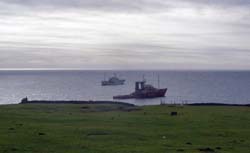 |
Wednesday 19th July
Report from Tristan Administrator Mike Hentley Captain Ian Carrasco came ashore yesterday as they were sending a crew member back to Cape Town on the Kelso (which sailed on Tuesday evening) on end of contract. He and his team have succeeded in stabilising the rig so that, once refloated, it will be seaworthy enough to make it to a dockyard for the full repairs needed. But the company have yet to complete arrangements to charter the second tug needed to refloat it and take it safely and securely under tow. Warren Glass of Natural Resources Department will join the salvage team environmental officer to ensure that all of our conservation interests are being met, and the Island Store is providing additional supplies for the crew as their stay here has been longer than initially planned!
|
| Photograph from Joe Green of the tug ST Zouros Hellas and MS Kelso anchored off the Tristan Settlement on 18th July. | |
| Thursday 20th July - Thursday 27th July Latest Edited News from Salvage Master Ian Carrasc0 Warren Glass joined the vessel on 20th July, and stores from the Island Store were taken aboard. Poor weather continued to prevent access for this period. No further news of a second tug being secured to assist in re-floating the rig. |
|
| Friday 28th July - 42nd day of Zouros Hellas' rescue mission Salvage Mission postponed for better weather and a more powerful tug Latest Edited News revised on 1st August Heavy weather conditions off Tristan da Cunha continue as forecast. A decision has been taken to postpone attempts to re-float the oil rig A Turtle until winter weather has moderated, so Zouros Hellas has now returned to Cape Town. The salvors will await favourable conditions and the availability of suitably powerful tug (s). This is unlikely to be until September at the earliest. The Insurance Company have advised Tristan that they are reputable, are not abandoning their responsibilities but are merely deferring the operation until later in the year in the difficult circumstances. |
|
August 2006 - Tristan waits for news Meanwhile, winter seas continue to batter the stricken rig, which is directly offshore the Trypot Rockhopper Penguin Rookery to which breeding pairs are now claiming nest sites ready for egg laying in September. Despite assurances from optimistic salvors, there must be a concern that the rig could break up to an extent that a salvage operation ( to its planned destination of Singapore for repairs ) will not be worth the expense, given the original state of the rig and subsequent damage. |
|
Dives to make environmental assessment - report updated on 25th September |
|
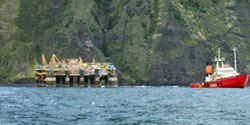 |
Four months on and counting
|
| October / November 2006 : MV Kelso charter for oil rig survey The Kelso was here from 28 October to 4 November on charter to London Overseas Consultants Ltd who represent the owners and insurers and who brought a survey team down to re inspect the rig and assess how best to remove it as soon as possible. Diver Sue Scott collected marine flora and fauna species and is assessing whether these could be of possible harm to the endemic varieties - which themselves were originally introduced here too. |
|
28th November 2006 A Turtle's last rights : confined to the deep
tristandc.com can reveal that the Governor of St Helena and its dependency Tristan da Cunha has issued a permit under the Environmental Protection (Overseas Territories) Order 1988, for the stranded rig to be disposed of at sea, with due regard to meeting environmental concerns. We now expect a suitably experienced contractor to be appointed to undertake the job of removing the rig as soon as possible. Work could begin as early as mid-December. It may be that the Kelso will be chartered to support the salvage work. If so, the Edinburgh will probably replace the MV Kelso on the first New Year scheduled sailing between Tristan & Cape Town. |
|
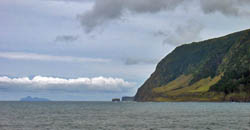 |
30th November : Oil Rig in perspective This photograph was taken during the St Andrew's Day circumnavigation of Tristan by HMS Edinburgh by Janice Hentley. It shows the grassy slopes of Tristan's eastern extremity at Sandy Point, the Oil Rig still stranded of Trypot Bay, the rugged lava peninsular of Stony Hill protruding behind, and to the South West the jagged Nightingale Island. HMS Edinburgh's helicopter also provided access to the rig for a survey team and we await their report and hopefully some spectacular photographs. |
| 30th November : Swiss Oil Rig Newspaper Article Zurich based newspaper Tages-Anzeiger has today published an article by journalist Christian Schmidt on the stranding of the oil rig "A Turtle" on the shores of Tristan da Cunha. The can be translated as : "An oil rig in a sea of silence".tristandc.com and the Tristan Administration provided information for the story, and the UK Foreign and Commonwealth Office have also provided a 'Press Lines' briefing containing questions and answers which are reproduced below. The January Tristan da Cunha Newsletter will feature a detailed feature on the oil rig saga, hopefully confirming its removal from Trypot's shores. |
|
| 11th December : Salvage Team Appointed to start work this month A contract for the salvage of the oil rig was awarded to Titan Maritime of Fort Lauderdale, USA on 6th December. Their team of salvage workers will sail from Cape Town in two parties and will arrive over the Christmas period. Their aim will be to carry out the work as quickly as possible. A contract for an environmental inspection will be signed shortly. |
|
| 14th December 2006 tristandc.com has learnt that a chartered plane will fly from Stansted Airport in England to Cape Town on 18th December with specialist equipment to be shipped to Tristan da Cunha to aid the efforts to remove the stranded oil rig from Trypot Reef. |
|
| 26th December 2006 MV Kelso arrived on Friday 22nd December with the advance salvage party plus the environmental team who will be completing the marine survey which Sue Scott started during her September visit. The salvage work to prepare the rig for floating began on 23rd December and will take an estimated three weeks. |
|
| 30th December 2006 The Titan salvage team have been working on the oil rig from MV Kelso all week in sometimes difficult conditions with strong winds and heavy sea swell. The environmental dive team (Warwick Sauer, Brian Godfrey & Ross Wanless) have also been assisting. |
|
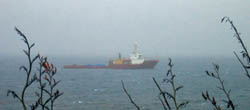 |
The 3180 tonne salvage tug De Hong, built in 2000 in China, chartered by salvors Titan and sailed from Cape Town on Christmas Eve, Sunday 24th December, and arrived at Tristan on Friday 29th December.
The picture (taken from above the harbour in driving rain by Janice Hentley) shows her at the anchorage. Captain Lu and his crew then took Towmaster Kees van Assem and the Titan new arrivals round to Trypot Bay. Once the tug is on station there, Kelso is expected to come up to the Settlement for supplies
|
 |
Salvage Underway Photograph from Tristan Administrator Mike Hentley of the salvage tug De Hong alongside the stricken oil rig A Turtle on Saturday 30th December getting (what is hoped will be) the final stage of the oil rig's removal underway. |
Thursday 4th January : Progress report from Mike Hentley |
|
Thursday 11th January : Progress report from Mike Hentley |
|
| Friday 18th January MV Edinburgh arrived in Trypot Bay and delivered important materials and additional fuel to the tug De Hong in support of the salvage operation. |
|
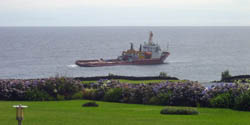 |
Half-Time Break? Report from Mike Hentley on 23rd January With preparation work to refloat the oil rig stranded at Trypot Bay about 50% complete, the salvage tug De Hong came up to Edinburgh Settlement on 23 January to top up water supplies, and the Kelso (on charter as support vessel) joined her later in the day so that the salvage team could stretch their legs and spend some hours ashore. Photo Janice Hentley |
| The beginning of the end? Could this be the start of the final countdown for the salvage operation?
Although it could take another 3 weeks yet, this formal 7 days notice below sent from the salvors Titan on 29th January enables the salvage team to take advantage of any favourable weather and sea conditions occurring after that to attempt to refloat the rig.
'...Titan may attempt to refloat the A TURTLE in approximately 7 days. The actually re-floating date will be determined on the success of the salvage team in the coming weeks, as well as the weather conditions'. News from Mike Hentley received 30th January 2007 |
|
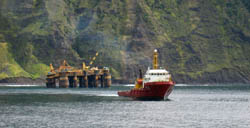 |
Titan makes 1st refloat attempt on 3rd February
The salvage team made a first attempt on Saturday 3 February to refloat the oil rig stranded at Trypot Bay. The top picture shows the tug De Hong putting up to 70% power onto the tow. However, although there was plenty of buoyancy on the port side of the rig, the tides were not sufficient to lift the starboard side clear of the reef.
The main attempt to refloat is still scheduled for mid-February, and the team will be working hard until then to regain some more of the buoyancy they need.
A photograph (middle) showing clearly (compared with the situation in December) how much of the structure has been cut away to remove weight to assist the salvage attempt and the amount of buoyancy obtained, particularly on the seaward size of the rig, where the previous waterline mark shows how much further the support columns have lifted out of the water. Lower photo. shows the two Tristan vessels Wave Dancer (cox Joe Green) and the police RIB Atlantic Dawn (cox Connie Glass) in Trypot Bay who went with MV Kelso (from where the photograph was taken) to lipase with the Tristan team on 3rd February. |
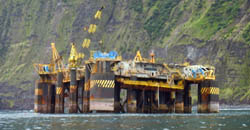 |
|
 |
|
| Fishing from MV Kelso View a photograph and report of Mark Swain's catch while aboard the MV Kelso, chartered to support the Titan team in Trypot Bay - see Fishing News Page. |
|
The final act : News from Administrator Mike Hentley received on 11th February 2007 I'm delighted to report that A Turtle finally turned turtle and was scuttled at a depth of 3500m some 10 miles east of Edinburgh settlement around 0600 on the morning of Sunday 11 February, some 9 months after being stranded on a reef off Tristan's south east coast. After last weekend's failed attempt to refloat and tow it off the reef at Trypot Bay, the Titan Salvage team began de-ballasting the rig on Friday for a second attempt. This ended abruptly with a broken tow line, and a third pull was then made late in the afternoon, with a successful refloating accomplished and the rig moved offshore.
Conditions remained favourable, so the tug De Hong then began the tow to the approved dump site at a speed of 3 knots, arriving there around 0200 on Sunday morning. The final phase of the operations to scuttle the rig commenced at first light, and ended with the structure listing to starboard before turning turtle and sinking rapidly into the depths.
Both the tug De Hong and the support vessel MV Kelso are now on their return journey to Cape Town, and are expected to arrive there by next weekend. RIP (Rust in Peace) (We hope to publish photographs of A Turtle's last turning later this week) |
|
Official Report of the final hours of the oil rig from the salvors Titan : This is to advise you that the oil rig 'A Turtle' has been towed out of Trypot Bay and scuttled within Tristanian waters. From Administrator Mike Hentley and published here on 18th February 2007 |
|
Bangs may not be what they may have appeared to be ....tristandc.com has learnt that reports have circulated that loud bangs being heard as the oil rig sank were due to air bags exploding. We have asked for confirmation and have had this reply from Mark Board of Seaflex Ltd of Cowes, Isle of Wright which supplied the air bags (as we know that many of our regular visitors would like to know correct details of this saga at its end): Those bangs that were heard would not have been the bags which collapse gently as the external pressure increases with depth. Very likely to have been the cylindrical sealed structures (legs etc) that would have resisted the increasing external pressure until they suddenly imploded.
It is this phenomenon that accounts for one of (what I think at least) the worlds most astonishing facts. When doing seismic surveys using explosives for the sound source in very deep water, the external water pressure is so great that even big charges produce only a wimpish 'bang'.
Solution, a glass sphere about 9" diameter is scoured with a tiny scratch which propagates failure at a predetermined depth of say 4000m. When it ruptures, the implosion is so violent it make a bigger bang than dynamite. The most amazing thing is the sphere is made in two halves with 'perfect mating edges' and just held together with tape until it submerges. Thereafter, the increasing water pressure forces the two halves together so tightly it doesn't leak until failure!
|
|
For the Future :
tristandc.com is still waiting for pictures of the final tow and scuttling - perhaps not of the latter as it took place in darkness. Enviro-Fish Africa Ltd of Cape Town will complete an environmental risk assessment of the stranding and subsequent salvage operations, and their report will be recommending longer term monitoring of the affected areas. The fact that the rig has been removed successfully means that there is very little risk of any pollution of the environment, which is very good news. Nevertheless we will make subsequent reports available here and a full prose assessment will be published in the July Tristan da Cunha Newsletter. |
|
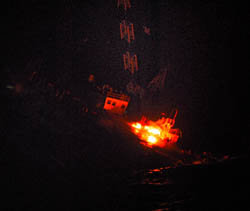 |
The Oil Rig Turning Turtle for the last time |
| Porgy Fish test death theory tristandc.com learns that a group of Brazilian porgy fish made the rig A Turtle their home and had swum with it as far as Tristan. The theory was that they would follow it to the dump site and then perish during the scuttling operations or be eaten by predators once their home had disappeared - thus ending another risk of alien species invasion! We await confirmation of their demise. |
|
